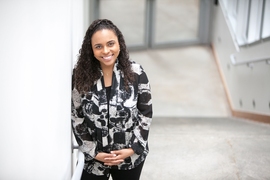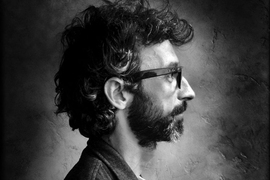Communicating through computers has become an extension of our daily reality. But as speaking via screens has become commonplace, our exchanges are losing inflection, body language, and empathy.
Danielle Olson ’14, a first-year PhD student at MIT’s Computer Science and Artificial Intelligence Laboratory (CSAIL), believes we can make digital information-sharing more natural and interpersonal, by creating immersive media to better understand each other’s feelings and backgrounds.
Olson’s research focuses on inventing and analyzing new forms of media, from gaming experiences to interactive narratives. Through a course last fall, she contributed to “The Enemy,” a virtual reality experience that lets users stand “face-to-face” with soldiers from opposing sides of global conflicts.
The project is the brainchild of photojournalist Karim Ben Khelifa, who worked on it with Fox Harrell, an associate professor of digital media with appointments in the MIT Comparative Media Studies/Writing Program and CSAIL. Khelifa traveled to places such as Israel, Palestine, and El Salvador to interview soldiers from different sides of conflicts. Under the guidance of Harrell, Olson helped work on algorithms that analyzed users’ body language in different scenarios. That information was then incorporated into the live experience: As the user listens to the soldiers, they can dynamically respond based on the user’s behavior.
Khelifa describes “The Enemy” as an effort to enable the public to develop more meaningful relationships to world events than they would simply by reading news articles.
“You’re looking someone in the eye as they describe death and war conflicts, and seeing their facial expressions and body language,” Olson says. “There’s a different level of empathy that you can cultivate with these sorts of technologies.”
Her other areas of research follow a similar thread of building empathy by examining different cultures. As part of Harrell’s Imagination, Computation, and Expression Laboratory, she’s working on developing interactive narrative experiences to help kids practice dealing with social identity issues. For example, one game involves an elf trying to get past a gatekeeper from a different clan, who may try managing the impressions others have of their identity to get past the gate. This work has already gained attention from notable artists like rapper Lupe Fiasco, who came into Harrell’s lab at MIT and offered feedback.
Growing up, Olson got a late start to coding. As a kid she wasn't one to play video games or pull apart computers, and didn't even know what MIT was until she watched “Iron Man” as a high-schooler. At 17 she was accepted to MIT's Minority Introduction to Engineering and Science Program (MITES) program, and she returned the following year as an undergraduate.
She says that her passion for education comes from her mother, who came to the U.S. from Cameroon with only an eighth-grade education before going on to earn her master’s degree.
“I always hear my mom’s voice saying that education is the one thing nobody can take away from you,” Olson says.
As an MIT senior she founded Gique, a nonprofit focused on teaching local students skills in STEAM — science, technology, engineering, arts, and math — embracing the intersection of art and technology. Her team creates hands-on curricula, experiments, and activities to help students develop more holistic viewpoints of the world.
“A 2008 study on ‘No Child Left Behind’ showed that half of the nation's districts decreased class time for art, drama, history, and science, which left students with a narrow learning environment,” she says. “We need to fight back against policies that discourage interdisciplinary education.”
Olson says that it’s vital for people in power to use their influence to help give underrepresented groups more access to resources that can level the playing field.
“I had access to programs like FIRST Robotics and MITES because I didn’t have to pay for them,” she says. “They’re sponsored by people who put their money where their mouth is and who aren’t just acknowledging the need for workplace diversity: They’re actually taking steps to invest directly in people of color."
Outside of her research and educational work, Olson feeds her creative pursuits, whether it’s cooking, reading comic books, or taking care of her pet rabbit and cat.
“I see my place as raising the next generation of computer science warriors who ingrain their culture into the fabric of computing,” she says. “I think it’s important to build systems that aren’t catered only to certain populations, but actually represent many values and bolster our political capital as developers, engineers, and makers.”
Fast Facts
Favorite place for news: Twitter
One thing people would be surprised to know about her: She was an MIT cheerleader. The year she started and served as co-captain was the first time in MIT history that the cheerleading team went to nationals.
Advice to incoming students: “You’re going to have failures. The master has failed more times than the beginner has even tried. Make sure you have an identity outside of research, so it’s not threatened when you hit a bump in the road.”
Her tech role model: Stacie LeSure Gregory, a postdoc at the American Association of University Women (AAUW). “She’s dedicated her career to empowering women and underrepresented groups in STEM.”










